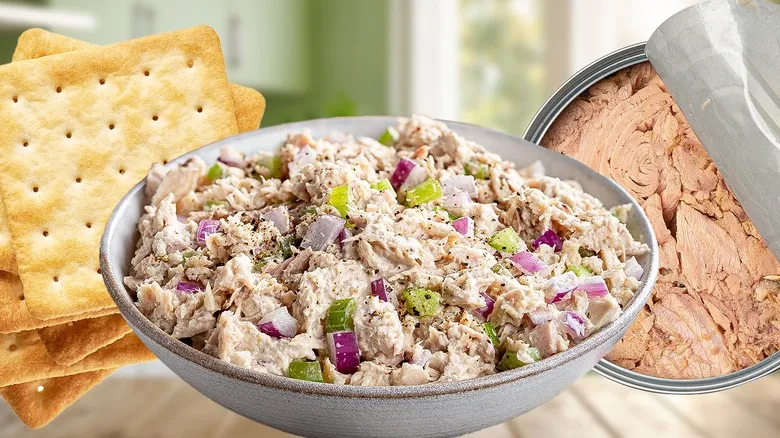1. Using the wrong type of tuna
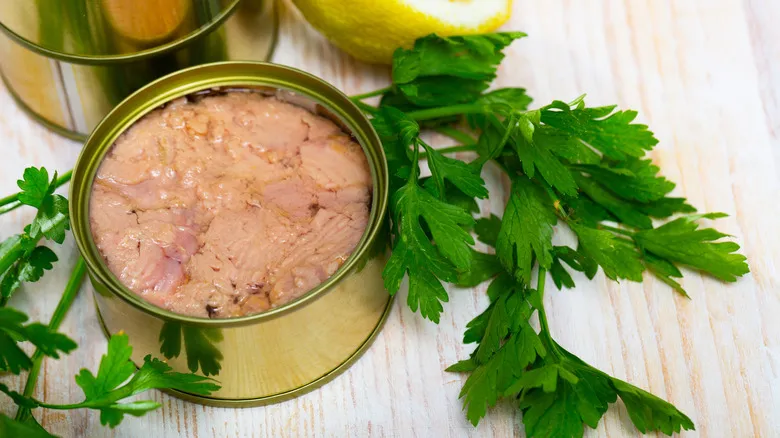
Take a leisurely walk through the canned fish aisle at the grocery store, and you'll likely encounter a variety of canned tuna options. You can select from albacore, yellowfin, skipjack, tongol, or bigeye tuna. Additionally, there are choices between solid, chunk, or flaked tuna. You can also decide whether you prefer your tuna packed in oil, brine, or water, and whether you want it salted or unsalted. While it may seem that all canned tuna is similar, each type offers unique qualities that can enhance your tuna salad.
Many people opt for albacore (often referred to as white tuna) for their tuna salad due to its milder flavor and firmer texture compared to other varieties. However, if you prefer a bolder tuna taste, you might want to consider light tuna, which is usually made from skipjack, yellowfin, or a blend of both. Solid, chunk, and chunk light tuna provide larger pieces, while flaked tuna has a finer consistency, making it ideal for mixing, though it can result in a slightly mushy salad. Many enthusiasts believe that tuna packed in oil is the best choice for tuna salad, as it adds a richness that water-packed tuna lacks.
2. Not considering fresh tuna or gourmet options
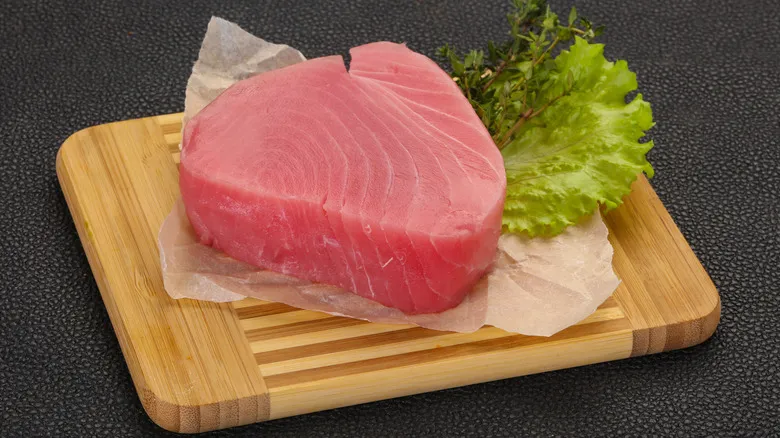
Canned tuna is the most affordable and convenient option for preparing tuna salad, but using fresh tuna can elevate your dish significantly. Premium fresh tuna is often meatier and creamier compared to its canned counterpart, and it generally contains much less sodium. The secret lies in selecting a high-quality tuna steak, such as albacore or yellowfin. You can enhance the flavor by brining or marinating the tuna beforehand. After that, you can grill, sauté, steam, or bake it. Once cooked, allow it to cool, then either shred it with a fork or cut it into pieces.
For an extra flavor boost, consider gourmet tuna, which can enhance both the taste and texture of your salad. Numerous brands offer high-quality tuna that chefs highly recommend. Many of these brands focus on pole or line-caught tuna, packed in delicious olive oil or vibrant sauces. Notable brands include Ortiz, Tonnino, and Genova. David Chang particularly enjoys Dongwan tuna in a spicy gochujang chile sauce. Additionally, you can find tuna in glass jars, allowing you to assess the fish's consistency and quality right away.
3. Improperly draining the tuna

One of the most frequent errors people make with canned tuna is failing to drain it properly. Regardless of whether your tuna is packed in water or oil, it's essential to ensure that all the liquid is removed before preparing your salad. If not, the liquid will dilute the mayonnaise, resulting in a soggy tuna salad. The most effective method is to place the tuna in a fine mesh strainer over a bowl or the sink. You can use a fork to press down on the tuna, allowing all the liquid to escape.
If you're using tuna packed in oil, you might want to save the oil for other recipes. It can be used to create a zesty vinaigrette for a fresh salad or as sautéing oil for a seafood dish. On the other hand, if you have tuna in water, there’s not much you can do with the leftover liquid, except perhaps give it to your pets. In that case, you can use the lid-draining technique. Simply open the can, hold it over the sink, and press the lid firmly into the can to let the water drain out. Be sure to apply even pressure on both sides of the lid to ensure all the liquid is removed.
4. Neglecting to add textural contrast
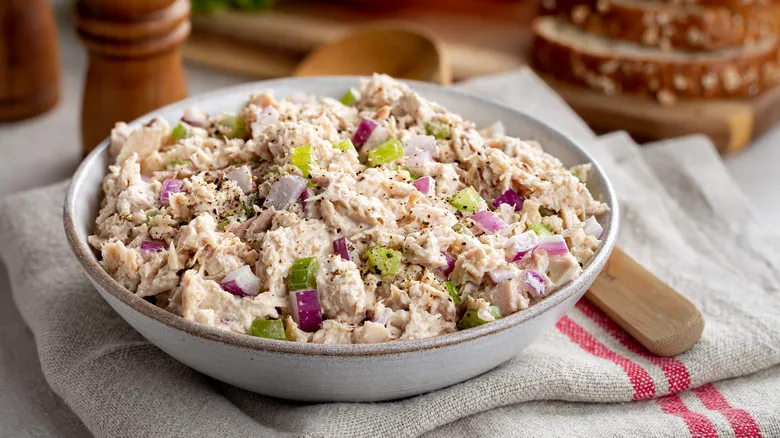
Whether you opt for canned or fresh tuna, the texture will be tender. When you mix in mayo, the result can be somewhat mushy and unexciting on its own. A well-crafted tuna salad should incorporate at least one crunchy element to provide textural contrast. You might also consider adding a range of textures to enhance the complexity of your tuna salad. Common additions include celery, onions, capers, bell peppers, and pickles.
Feel free to experiment with unique ingredients to introduce some crunch to your tuna salad. Sometimes, unexpected components can yield delightful results. For instance, Martha Stewart swears by diced apples as her secret ingredient for an exceptional tuna salad. It may seem unusual, but the fruit's sweetness beautifully complements the savory flavors of the fish. Gordon Ramsay takes his tuna salad up a notch with French green beans, tapenade, and a poached quail egg. Meanwhile, Matthew McConaughey proudly refers to himself as a "tuna fish salad master maker" on the 2 Bears, 1 Cave podcast, sharing that he includes red onions, dill gherkins, crispy jalapeño chips, corn kernels, diced apples, and frozen peas in his recipe.
5. Making it too chunky

When preparing your tuna salad, it's important to achieve a balance of textural variety while ensuring that all ingredients are thoroughly blended. Unless you're aiming for a chopped tuna salad with greens, avoid large chunks, as they can make the salad harder to eat and may overshadow the other flavors, resulting in an unappealing texture. Ideally, each bite should allow you to savor all the flavors you've included.
To start making your tuna salad, use a fork to fluff the canned tuna, breaking it into smaller pieces for easier mixing with the other ingredients. Next, finely chop your vegetables using a sharp knife. Some people prefer using a food processor or a grater for tougher ingredients. You might also want to peel the celery to eliminate any stringy bits. Once all your ingredients are in the bowl, mix them thoroughly to ensure an even distribution throughout the salad.
6. Leaving out an acidic element
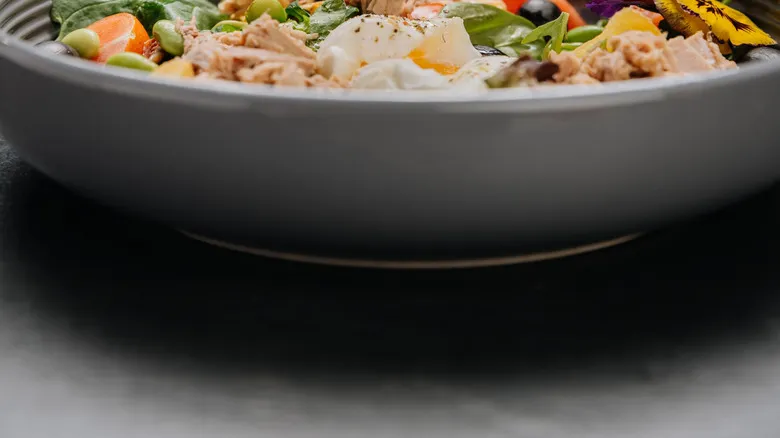
If you notice that your tuna salad lacks flavor or freshness, it might be due to the absence of an acidic element. Adding acid can help counterbalance the mildness and creaminess of the mayonnaise and the richness of the tuna, enhancing the overall flavor and making your salad more vibrant. If your canned tuna is packed in brine, you might already have a hint of tanginess. If not, there are numerous ways to introduce acidity to your tuna salad.
Common acidic ingredients that people often incorporate into tuna salad include lemon juice, mustard, and vinegar. Alternatively, you can replace mayonnaise with a creamy ingredient that has some acidity, such as sour cream or Greek yogurt. Ingredients like pickles, olives, and capers can provide both acidity and a pleasing textural contrast. If you enjoy a bit of heat, jalapeños and banana peppers are also excellent acidic additions. Just be cautious not to overdo it, as too much acid can make your tuna salad excessively sour. The secret to achieving the right level of tang is to add the acidic components gradually and taste as you mix.
7. Overloading on wet ingredients
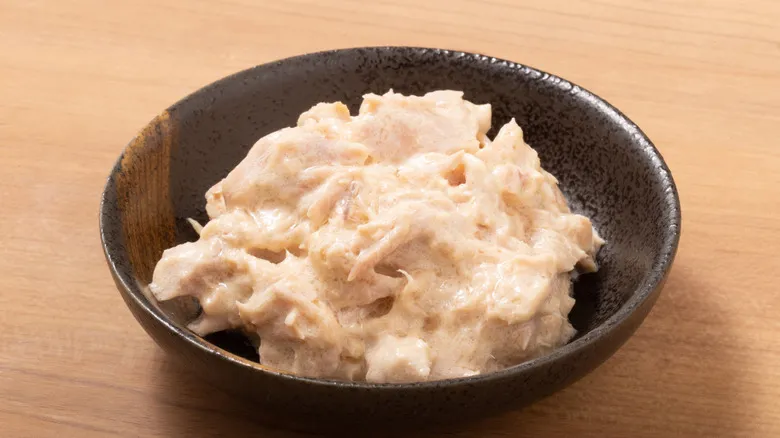
Tuna salad recipes can differ widely, but one common ingredient in most is mayonnaise. The mayo serves as a binder, keeping the tuna and other components together while adding a delightful creaminess to the dish. However, using too much mayo can result in a messy, overly wet salad. To prevent your tuna salad from becoming overly saturated, it's advisable to start with a small amount. A common suggestion is to use about 1 tablespoon of mayo for each can of tuna. Mix in the mayo and then check the consistency; you can always add more, but removing it once it's mixed in is nearly impossible.
Also, remember that any wet ingredients you incorporate will make the tuna salad more liquidy. Be cautious with liquids like lemon juice and mustard. It might be a good idea to pat dry any wet vegetables, such as tomatoes, capers, or cucumbers, before adding them to your salad. If you find you've added too many wet ingredients, you may need to incorporate additional tuna or other dry components to help distribute the mayonnaise more evenly. A creamier tuna salad can be great for sandwiches, but consider using thick bread. Toasting the bread can also help avoid soggy sandwiches.
8. Underseasoning the salad
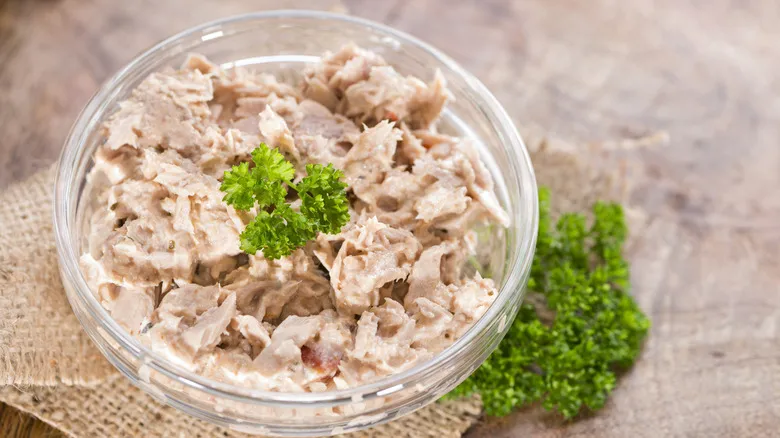
Any chef will agree that seasoning is essential for transforming any dish into something extraordinary, and tuna salad is no different. While tuna has its own distinct flavor, mayonnaise is quite mild, so it requires additional ingredients to elevate the taste of the fish. At a minimum, your tuna salad should include salt to enhance the savory aspects of the tuna and the sweetness of the mayo. As previously mentioned, acidic components like lemon juice and mustard can really brighten up your salad. You might also consider incorporating herbs and spices such as oregano, thyme, or cumin.
To add more personality to your tuna salad, think about using everything bagel seasoning. This blend of salt, onion, garlic, poppy seeds, and sesame seeds will introduce salty and savory flavors along with a delightful crunch. If you prefer a bit of heat, hot sauce and chili powder can spice things up, while sweet relish can balance the richness of the mayo and tuna. Additionally, you can draw inspiration from various global cuisines; for instance, curry powder can impart an Indian flair, while wasabi can lend a Japanese twist to your dish.
9. Skipping fresh ingredients
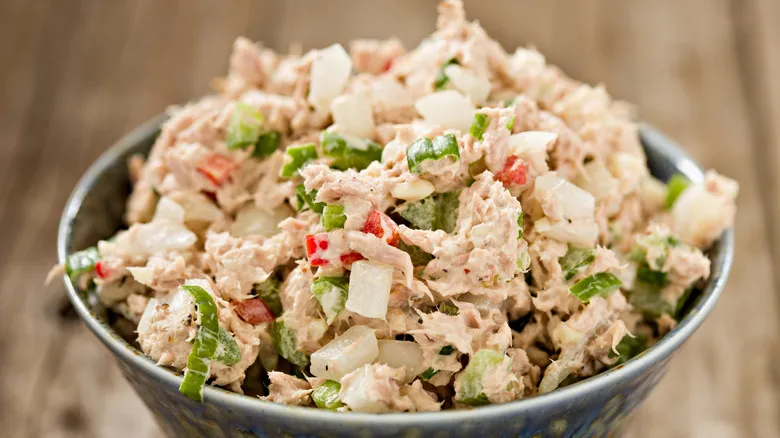
One of the simplest ways to elevate your tuna salad from ordinary to exceptional is by adding fresh ingredients. Alongside diced vegetables, consider incorporating some fresh herbs. The vibrant flavors and fragrances of the herbs will introduce an extra layer of complexity to your salad. Additionally, herbs will provide bursts of color and enhance the texture. Parsley is a traditional addition to tuna salad that complements the other flavors without overpowering them. You might also try adding dill, or for a citrusy, herbaceous twist, consider tarragon, or even some chopped basil.
Another opportunity to freshen up your tuna salad lies in your mayonnaise. While making mayo at home may seem intimidating, it’s actually quite straightforward. All you need are oil, eggs, mustard, and vinegar or lemon juice. Using a hand blender or food processor, combine the eggs, mustard, and vinegar, then gradually add the oil while blending until the mixture becomes thick and creamy. Many people swear by homemade mayonnaise, claiming it tastes significantly better than store-bought versions, plus it’s free from preservatives.
10. Not balancing flavors
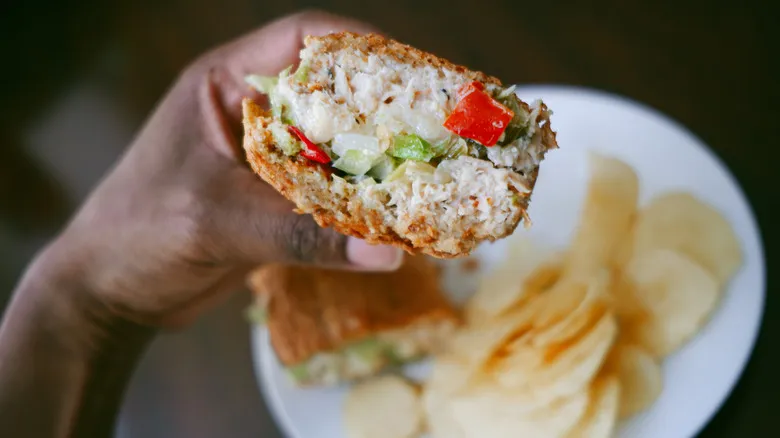
With all the discussion about enhancing your tuna salad with additional ingredients, you might assume we're suggesting you toss in everything imaginable. That's not quite the case. There's a delicate balance between enhancing flavors and going overboard. The goal is to ensure that all the flavors work harmoniously together, without any single ingredient dominating the dish. Achieving balance is essential in any recipe, even one as simple as tuna salad.
To achieve a harmonious flavor profile in your tuna salad, consider the flavor characteristics each ingredient contributes. If you're incorporating tangy elements like lemon juice and mustard, you might want to offset that with something sweet, such as sweet pickle relish or a dash of sugar. Salty components can enhance the sweetness of the mayonnaise and counteract any bitterness from ingredients like parsley. If you find the dish too salty, a touch of sugar or acid can help balance it out. It's a good idea to taste your tuna salad as you prepare it, allowing you to make adjustments for the ideal flavor balance.
11. Forgetting to chill the salad

One reason tuna salad often tastes better at restaurants than at home is that restaurants usually chill their tuna salad. There are several factors contributing to this. First, refrigerating the salad allows the flavors to blend together. Additionally, chilled tuna salad has a firmer texture compared to one at room temperature, making it easier to hold together in a sandwich and scoop onto crackers. The cool temperature also provides a refreshing sensation, enhancing the enjoyment of fresh ingredients like crunchy celery and herbs.
If you can't wait to enjoy your tuna salad or need to leave it out for an event like a potluck or barbecue, it's crucial not to let it sit out for too long. The FDA advises against keeping perishable foods at room temperature for more than two hours, and this limit decreases to one hour if the temperature exceeds 90 degrees Fahrenheit. Bacteria can multiply rapidly between 40 and 140 degrees Fahrenheit, so it's important to avoid giving them a chance to grow. As for how long tuna salad can be stored in the fridge, a good guideline is three to four days. Most experts do not recommend freezing tuna salad, as the texture can become mushy upon thawing.
12. Serving the salad with boring bread or crackers
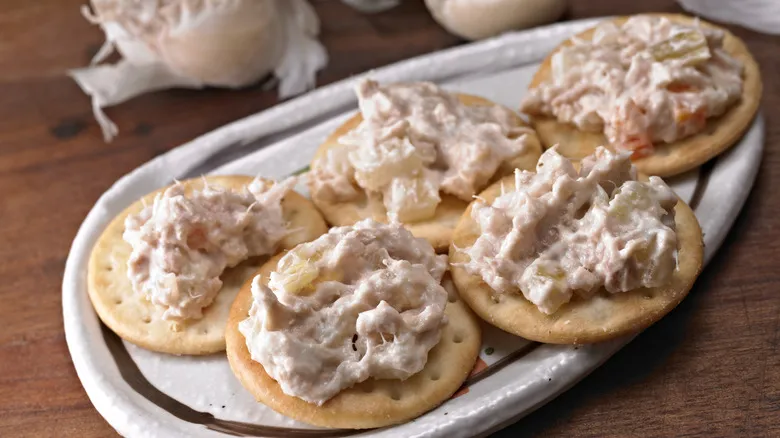
While plain white bread is a common choice for tuna salad sandwiches, it can often feel a bit lackluster. It tends to lack the sturdiness needed to support a generous amount of tuna salad and can become soggy quickly. To elevate your tuna salad sandwich, try using thick whole wheat bread for added flavor and durability. A soft bun can also be a great alternative, providing a similar texture to white bread but with a bit more substance. For a heartier option, consider a crusty baguette or indulge in a flaky, buttery croissant for a touch of luxury.
If you're serving tuna salad as a snack or appetizer, crackers make an excellent choice for scooping and holding the salad. Many people enjoy buttery crackers, as they enhance the creaminess of the dish. However, feel free to experiment with various types of crackers. Rice crackers can introduce a satisfying crunch, cheese crackers can boost the flavor, and saltines can add a hint of saltiness. You might also think outside the box and use lettuce leaves, cucumber slices, or bell pepper strips as a fresh alternative for holding the tuna salad.
Recommended

The Ingredient Fad That Martha Stewart Loves To Hate

Transform Your Frozen Pizza Crust With One Simple Extra Step

Granulated Garlic Vs Garlic Powder: Which One Works Best In Your Recipe?

A Comma In A Recipe Can Mean A Lot More Than You Think It Does
Next up

